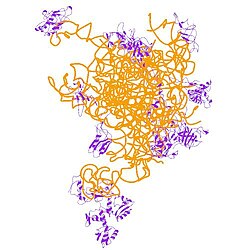

| MRPL19 | |||||||||||||||||||||||||||||||||||||||||||||||||||
|---|---|---|---|---|---|---|---|---|---|---|---|---|---|---|---|---|---|---|---|---|---|---|---|---|---|---|---|---|---|---|---|---|---|---|---|---|---|---|---|---|---|---|---|---|---|---|---|---|---|---|---|
 | |||||||||||||||||||||||||||||||||||||||||||||||||||
| |||||||||||||||||||||||||||||||||||||||||||||||||||
| Identifiers | |||||||||||||||||||||||||||||||||||||||||||||||||||
| Aliases | MRPL19, L19mt, MRP-L15, MRP-L19, MRPL15, RLX1, RPML15, mitochondrial ribosomal protein L19 | ||||||||||||||||||||||||||||||||||||||||||||||||||
| External IDs | OMIM: 611832; MGI: 1926274; HomoloGene: 8851; GeneCards: MRPL19; OMA:MRPL19 - orthologs | ||||||||||||||||||||||||||||||||||||||||||||||||||
| |||||||||||||||||||||||||||||||||||||||||||||||||||
| |||||||||||||||||||||||||||||||||||||||||||||||||||
| |||||||||||||||||||||||||||||||||||||||||||||||||||
| |||||||||||||||||||||||||||||||||||||||||||||||||||
| |||||||||||||||||||||||||||||||||||||||||||||||||||
| Wikidata | |||||||||||||||||||||||||||||||||||||||||||||||||||
| |||||||||||||||||||||||||||||||||||||||||||||||||||
39S ribosomal protein L19, mitochondrial is a protein that in humans is encoded by the MRPL19 gene.[5][6][7]
Mammalian mitochondrial ribosomal proteins are encoded by nuclear genes and help in protein synthesis within the mitochondrion. Mitochondrial ribosomes (mitoribosomes) consist of a small 28S subunit and a large 39S subunit. They have an estimated 75% proteintorRNA composition compared to prokaryotic ribosomes, where this ratio is reversed. Another difference between mammalian mitoribosomes and prokaryotic ribosomes is that the latter contain a 5S rRNA. Among different species, the proteins comprising the mitoribosome differ greatly in sequence, and sometimes in biochemical properties, which prevents easy recognition by sequence homology. This gene encodes a 39S subunit protein.[7]
|
PDB gallery
| |
|---|---|
|
2ftc: Structural Model for the Large Subunit of the Mammalian Mitochondrial Ribosome
|
|
| |||||||||||||||||||||||||||||||||
|---|---|---|---|---|---|---|---|---|---|---|---|---|---|---|---|---|---|---|---|---|---|---|---|---|---|---|---|---|---|---|---|---|---|
| Proteins |
| ||||||||||||||||||||||||||||||||
| Other concepts |
| ||||||||||||||||||||||||||||||||
|
Ribosomal RNA / ribosome subunits
| |||||||
|---|---|---|---|---|---|---|---|
| Archaea (70S) |
Small (30S): | ||||||
| Bacteria (70S) |
Small (30S): | ||||||
| Eukaryotes |
| ||||||
| Ribosomal proteins | (See article table) | ||||||
This article on a gene on human chromosome 2 is a stub. You can help Wikipedia by expanding it. |
This protein-related article is a stub. You can help Wikipedia by expanding it. |